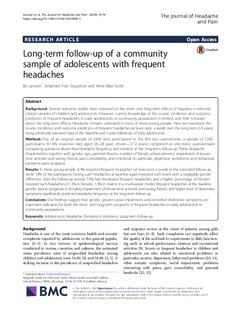| dc.description.abstract | Background
Several outcome studies have reported on the short- and long-term effects of migraine in selected clinical samples of children and adolescents. However, current knowledge of the course, incidence, and outcome predictors of frequent headaches in early adolescents in community populations is limited, and little is known about the long-term effects. Headache remains untreated in most of these young people. Here we examined the course, incidence, and outcome predictors of frequent headaches (at least once a week) over the long term (14 years) using previously assessed data at the baseline and 1-year follow-up of early adolescents.
Methods
Out of an original sample of 2440 who participated in the first two assessments, a sample of 1266 participants (51.9% response rate) aged 26–28 years (mean = 27.2 years) completed an electronic questionnaire comprising questions about their headache frequency and duration at the long-term follow-up. These headache characteristics together with gender, age, parental divorce, number of friends, school absence, impairment of leisure-time activities and seeing friends, pain comorbidity, and emotional (in particular, depressive symptoms) and behavioral problems were analyzed.
Results
In these young people, 8.4% reported frequent headaches (at least once a week) at the extended follow-up, while 19% of the participants having such headaches at baseline again reported such levels with a negligible gender difference. Over the follow-up period, 7.4% had developed frequent headaches, and a higher percentage of females reported such headaches (11.3% in females, 1.5% in males). In a multivariate model, frequent headaches at the baseline, gender (worse prognosis in females), impairment of leisure-time activities and seeing friends, and higher level of depressive symptoms significantly predicted headache frequency at the long-term follow-up.
Conclusions
Our findings suggest that gender, greater social impairment, and comorbid depressive symptoms are important indicators for both the short- and long-term prognosis of frequent headaches in early adolescents in community populations. | nb_NO |

